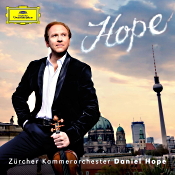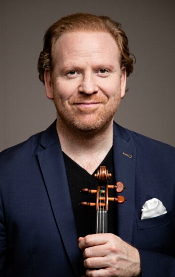Works by Ramirez, Dowland, Schubert, Giazotto, El-Hkoury, Part, Elgar, Foster, Andre, and traditional selections. Daniel Hope, violin; Zurcher Kammerorchester; Ensemble Amarcord, Katta; Patrick Messina; Jacques Ammon; Thomas Hampson; Julia Okruashvili; Marie-Pierre Langlamet; Colin Rich; and the Palau de la Musica Vocal Quartet. DG 486 0541.
By John J. Puccio
“Hope is being able to see that there is light despite all of the darkness.” --Desmond Tutu
“Music has a tremendous power. This album is my attempt to send out a ray of hope and to provide people, myself included, with a sense of support and perhaps even consolation.” --Daniel Hope
For those few who may not, perhaps, be completely familiar with Daniel Hope, he is a South African-born classical violinist (b. 1973) of world renown who is also the Music Director of the Zurich Chamber Orchestra and the New Century Chamber Orchestra. He plays the 1742 "ex-Lipinski" violin by Giuseppe Guarneri del Gesu.
Hope conceived and recorded the present album during lockdown, 2020, and in it he attempts to produce “a highly personal, yet distinctive collection of timeless classics by Schubert, Elgar, Part,” (and others). A booklet note continues, saying “Music was one of the first things to which people turned impulsively during the first coronavirus lockdowns in the spring of 2020.... Making music and in particular singing brought the world closer together after social distancing had created greater barriers than ever before.”
So, it’s music of hope. Music of trust. Music of promise. Music of expectation for all of us to come together. To that end, it includes works by Ariel Ramirez, John Dowland, Franz Schubert, Remo Giazotto, Bechara El-Hkoury, Arvo Part, Edward Elgar, Stephen Foster, and Fabian Andre, as well as traditional selections like “Danny Boy” and “Amazing Grace.”
Although it may seem like a kind of eclectic approach for a theme album, incorporating as it does a number of short, sometimes seemingly disparate works, it amply displays Mr. Hope’s expressive violin playing and his sincere intent. Accompanying Mr. Hope in the various pieces are the Zurich Chamber Orchestra; Ensemble Amarcord; organist Katta; clarinetist Patrick Messina; pianist Jacques Ammon; baritone Thomas Hampson; pianist Julia Okruashvili; harpist Marie-Pierre Langlamet; vocalist Colin Rich; and the Palau de la Musica Vocal Quartet.
The album begins with Misa Criolla (“Creole Mass” or “Native Mass”) by Argentine composer Ariel Ramirez (1921-2010), here arranged for solo violin, vocal quartet, charango (a ten-stringed mandolin), guitar, percussion, and string orchestra. The Paulau de la Musica Vocal Quartet, various instrumentalists, and the Zurich Chamber Orchestra accompany Mr. Hope. Appropriate to the album’s theme, Ramirez said he wrote the Mass as a “spiritual” piece designed to express humanity’s hopes of a better world. At a little over twenty minutes in length, it is also the longest selection on the program. Hope’s violin tone is plaintive yet uplifting from the outset. The quicker-paced succeeding movements are more spirited affairs with more-obvious Hispanic influences. It’s a splendid piece, well played, and well recorded.
The next selections are short songs arranged for violin and vocal ensemble. The first of these is Time Stands Still by English composer John Dowland (1563-1626), and the second is Die Nacht by Franz Schubert (1797-1828). In both, the Ensemble Amacord accompanies Mr. Hope. Although these works can be a bit mournful, they convey a lovely sentiment, with Mr. Hope’s violin adding a heartwarming quality to the proceedings. The Schubert is downright tear-jerking.
Then we get a longer, instrumental work, the famous Adagio in G minor by Remo Giazotto (1910-1998), with Mr. Hope, organist Katta, and the Zurich Chamber Orchestra. Giazotto always contended he transcribed the Adagio from a long-lost manuscript by the Italian Baroque composer Tomaso Albinoni (1671-1751), but that claim remains in doubt. Whatever, we get a terrific account of it here, neither too sentimental nor too matter-of-fact. It glides smoothly along on the back of Katta’s organ passages, with a rather forward part for the soloist.
Mr. Hope rounds out the album with over half a dozen shorter works: Byblos, the Old City by Bechara El-Khoury; Spiegel im Spiegel by Arvo Part; Nimrod from the Enigma Variations by Edward Elgar; “Dream a Little Dream” by Fabian Andre and Wilbur Schwandt; “Ah! May the Red Rose Live Alway” by Stephen Foster; and two traditional songs, “Danny Boy” and “Amazing Grace.”
In short, it’s an endearing album, if perhaps more than a tad on the solemn side. Still, the music is so beautiful and so beautifully performed, one cannot help going away impressed and, yes, hopeful.
Producers Christoph Classen and Tobias Lehmann and engineer Rene Moller recorded the music at XKO-Haus, Zurich and Teldex Studio, Berlin in July, September, and December 2020. The sound exhibits excellent transient response and dynamics, with clear percussion and strong bass. The engineers ensure the violin is well integrated with the rest of the instruments and voices, not too recessed nor too far out front. The overall tone is a trifle soft, which is better than its being too bright or edgy, yet it maintains good, lifelike definition. It’s a pleasantly listenable disc, as are most of the DG recordings I’ve heard lately.
JJP
To listen to a brief excerpt from this album, click below:
By John J. Puccio
“Hope is being able to see that there is light despite all of the darkness.” --Desmond Tutu
“Music has a tremendous power. This album is my attempt to send out a ray of hope and to provide people, myself included, with a sense of support and perhaps even consolation.” --Daniel Hope
For those few who may not, perhaps, be completely familiar with Daniel Hope, he is a South African-born classical violinist (b. 1973) of world renown who is also the Music Director of the Zurich Chamber Orchestra and the New Century Chamber Orchestra. He plays the 1742 "ex-Lipinski" violin by Giuseppe Guarneri del Gesu.
Hope conceived and recorded the present album during lockdown, 2020, and in it he attempts to produce “a highly personal, yet distinctive collection of timeless classics by Schubert, Elgar, Part,” (and others). A booklet note continues, saying “Music was one of the first things to which people turned impulsively during the first coronavirus lockdowns in the spring of 2020.... Making music and in particular singing brought the world closer together after social distancing had created greater barriers than ever before.”
So, it’s music of hope. Music of trust. Music of promise. Music of expectation for all of us to come together. To that end, it includes works by Ariel Ramirez, John Dowland, Franz Schubert, Remo Giazotto, Bechara El-Hkoury, Arvo Part, Edward Elgar, Stephen Foster, and Fabian Andre, as well as traditional selections like “Danny Boy” and “Amazing Grace.”
Although it may seem like a kind of eclectic approach for a theme album, incorporating as it does a number of short, sometimes seemingly disparate works, it amply displays Mr. Hope’s expressive violin playing and his sincere intent. Accompanying Mr. Hope in the various pieces are the Zurich Chamber Orchestra; Ensemble Amarcord; organist Katta; clarinetist Patrick Messina; pianist Jacques Ammon; baritone Thomas Hampson; pianist Julia Okruashvili; harpist Marie-Pierre Langlamet; vocalist Colin Rich; and the Palau de la Musica Vocal Quartet.
The album begins with Misa Criolla (“Creole Mass” or “Native Mass”) by Argentine composer Ariel Ramirez (1921-2010), here arranged for solo violin, vocal quartet, charango (a ten-stringed mandolin), guitar, percussion, and string orchestra. The Paulau de la Musica Vocal Quartet, various instrumentalists, and the Zurich Chamber Orchestra accompany Mr. Hope. Appropriate to the album’s theme, Ramirez said he wrote the Mass as a “spiritual” piece designed to express humanity’s hopes of a better world. At a little over twenty minutes in length, it is also the longest selection on the program. Hope’s violin tone is plaintive yet uplifting from the outset. The quicker-paced succeeding movements are more spirited affairs with more-obvious Hispanic influences. It’s a splendid piece, well played, and well recorded.
The next selections are short songs arranged for violin and vocal ensemble. The first of these is Time Stands Still by English composer John Dowland (1563-1626), and the second is Die Nacht by Franz Schubert (1797-1828). In both, the Ensemble Amacord accompanies Mr. Hope. Although these works can be a bit mournful, they convey a lovely sentiment, with Mr. Hope’s violin adding a heartwarming quality to the proceedings. The Schubert is downright tear-jerking.
Then we get a longer, instrumental work, the famous Adagio in G minor by Remo Giazotto (1910-1998), with Mr. Hope, organist Katta, and the Zurich Chamber Orchestra. Giazotto always contended he transcribed the Adagio from a long-lost manuscript by the Italian Baroque composer Tomaso Albinoni (1671-1751), but that claim remains in doubt. Whatever, we get a terrific account of it here, neither too sentimental nor too matter-of-fact. It glides smoothly along on the back of Katta’s organ passages, with a rather forward part for the soloist.
Mr. Hope rounds out the album with over half a dozen shorter works: Byblos, the Old City by Bechara El-Khoury; Spiegel im Spiegel by Arvo Part; Nimrod from the Enigma Variations by Edward Elgar; “Dream a Little Dream” by Fabian Andre and Wilbur Schwandt; “Ah! May the Red Rose Live Alway” by Stephen Foster; and two traditional songs, “Danny Boy” and “Amazing Grace.”
In short, it’s an endearing album, if perhaps more than a tad on the solemn side. Still, the music is so beautiful and so beautifully performed, one cannot help going away impressed and, yes, hopeful.
Producers Christoph Classen and Tobias Lehmann and engineer Rene Moller recorded the music at XKO-Haus, Zurich and Teldex Studio, Berlin in July, September, and December 2020. The sound exhibits excellent transient response and dynamics, with clear percussion and strong bass. The engineers ensure the violin is well integrated with the rest of the instruments and voices, not too recessed nor too far out front. The overall tone is a trifle soft, which is better than its being too bright or edgy, yet it maintains good, lifelike definition. It’s a pleasantly listenable disc, as are most of the DG recordings I’ve heard lately.
JJP
To listen to a brief excerpt from this album, click below:



No comments:
Post a Comment
Thank you for your comment. It will be published after review.